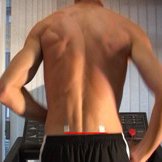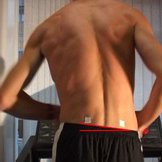Hip & back pain
Common conditions affecting the hip include arthritis, sciatica, trochanteric bursitis and iliotibial band syndrome. Conditions such as this are caused by biomechanical imbalances readily identified at the Centre using in-depth biomechanical assessment and gait analysis.
One common reason for hip related symptoms is the presence of a leg length discrepancy and the Centre often receives referrals where such imbalances are specifically assessed and treated. Apart from using clinical methods, the Centre also uses advanced ultrasound and CT / x-ray technology to accurately measure leg length discrepancies. Treatment includes specialist orthoses and footwear modification. In extreme cases the leg can be surgically lengthened and we work with a consultants who speciale in this type of surgery and who we can refer to if appropriate.
The connection between compromised back function and foot and leg mal-alignment is well documented. In most cases back pain is caused, at least in part, by the presence of abnormal biomechanical forces. At The London Podiatry Centre detailed biomechanical assessment and gait analysis is undertaken to diagnose misalignments, so that effective treatment can be expedited.
One mechanism which can lead to back pain is known as sagittal plane restriction. In this instance, normal forward progression of the body is impeded so leading to muscle fatigue and core weakness. Examples include functional "locking" of the great-toe joint and restrictions within the ankle joint. These restrictions can be subtle and may not be picked up without in-depth analysis and gait studies. Once gait analysis has determined the cause of your back pain, then a range of treatment options will be considered to manage your symptoms and these include:
1) Gait re-education and rehabilitation with the assistance of our on site specialist MSK physiotherapist
2) Spinal and pelvic manipulation, often done after additional x-rays have been take of the spine and pelvis. These x-rays must be taken standing so that appropriate measurements can be taken to allow for a targeted an highly specific manipulation. Our team works closely with some exceptional manipulative specialists.
3) Correction of postural sway deficiencies: This is necessary when your gait assessment demonstrates compromised balance and proprioceptive awareness. A specific programme to improve this is implemented.
4) Correction of ergonomic environment: There are many factors that could play a role in your back pain and these will be carefully considered as part of a holistic treatment approach. These include, bed type, desk posture (ie use of standing desk), chair type, lifestyle etc.
5) Specialist medical appliances: Devices such as orthoses may be used to improve foot function so that your back operates from a more stable platform. Abnormal pronation (abnormal collapse of the ankle and arch) can result in weakening of the buttock muscles (glutei) which are essential for normal back function. Orthoses can facilitate normal forward progression and address differences in leg length.
Please contact the centre for more information.
This is an example of excessive hip drop during running has caused symptoms in this athlete.



